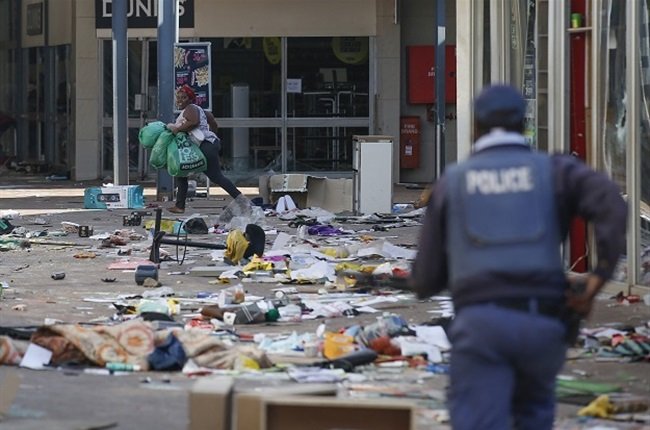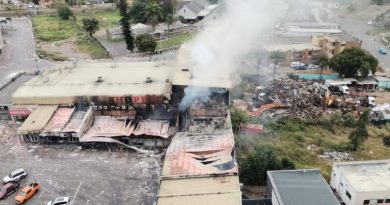Who really pays for the damages caused by civil commotion
It will take many months for South African businesses to rebuild following the loss and damage caused by civil commotion in parts of Gauteng and KwaZulu-Natal, and even longer for the psychological scars suffered by its citizens to heal. As the dust settles, economists are taking stabs at the eventual price tag.
Assessing the damage
Some put the insured losses, being damages for which individuals and business have insurance cover, at around R15 billion, but the overall cost to the South African economy is multiples of this number.
“The economic disruption caused by the unrest and the resulting down-time as critical business infrastructure is rebuilt, could wipe more than R50 billion rand from the country’s 2021 GDP,” says Hennie Nortje, Executive for claims Centre of Excellence at Old Mutual Insure. This would reduce the country’s post-economic growth by as much as 0.7%.
Old Mutual Insure is concerned about the lasting impact of the civil commotion on all South Africans, but especially on those who do not have adequate protection against such losses.
Who really pays?
“Aside from the huge impact on our economy, the unrest may lead to job losses and create an additional hurdle for foreign investors who might have been considering investing in the country,” says Nortje. He says that the disruption to logistics and manufacturing sectors would result in consumers paying higher prices for certain goods, while insurance premiums to cover future loss events would inevitably rise.
The unique structure of South Africa’s insurance industry, coupled with tight regulatory controls around insurer solvency, means that there is enough cash for insurers to meet their obligations to insured individuals and businesses.
“We have a state-owned special risks insurer, Sasria, that operates independently to cover insureds from losses caused by civil commotion, public disorder, strikes, riots and terrorism,” says Nortje. But the key word in the above comment is insureds.
Insist on SASRIA cover
Sasria cover is ‘sold’ as an optional add-on to an existing commercial or personal insurance policy. The cover is cheap relative to the premium on the main contract, so many insureds take it. Businesses that do not have insurance, and most of those who have an insurance policy without the special risks add-on, will have to foot their losses themselves or turn to government for help. For those who are insured, and have Sasria cover, the outlook is more positive.
“It is very important that consumers and businesses insist on SASRIA cover precisely because of what recent events have proved. While no one may have seen an event of such a magnitude coming, the point of insurance is to protect one against risk.”
How SASRIA cover works to protect against business interruption losses
For businesses, Sasria cover is proving pivotal to ensure they have funds available to pay expenses when the business is not able to trade after a loss.
Nortje explains that SASRIA cover for Business Interruption is available for Standing Charges, Working Expenses, Net Profit or gross profit. They define the cover as follows:
- Gross profits: Insurance gross profit is defined as: turnover less purchases, bad debts and any other expense deemed variable (adjusted for year-end stock and work in progress variation).The Policy Number is identified as “GP” and applies to those covers arranged to cover only GROSS PROFIT of the Insured’s Business.
- Working expenses: This basis is by far the most satisfactory method of arranging this cover. The Schedule is identified by the “WE” which forms part of the Policy Number. Only those Expenses mentioned are not covered. All other Fixed Expenses are covered.
- Standing charges: The Policy Number is identified as “SC” and applies to those covers arranged to cover only certain fixed expenses/ standing charges of the Insured’s Business. Those not mentioned will not be covered
- Net Profit: The Policy Number is identified as “NP” and applies to those covers arranged to cover only NET PROFIT of the Insured’s Business. The limit for the net profit would need to be listed on the Sasria Policy, whether it is insured withstanding Charges or Working Expenses
“It is important to note that you don’t have to have Business Interruption insurance on your normal policy to qualify for SASRIA Business Interruption, you only need to have cover on a SASRIA property damage coupon to qualify,” says Nortje.
History of SASRIA
Nortje points out that Sasria came about to help traditional insurers with exactly this type of widespread civil commotion.
“The special risks insurer was established following the 1976 Soweto uprising, when the insurance industry realised the need for a dedicated risk pool from which to pay-out claims resulting from widespread loss and damage events,” he says.
The special risks insurer has stepped up to the plate each year since its establishment, religiously collecting premium from insureds, meeting the claims made against its cover, and paying profits over to its only stakeholder, government. In its 2020 financial year, to end-March 2020, the insurer collected R2.417 billion in premiums and paid R991 million in claims. This compares to R2.169 billion and R1.578 billion in the prior year.
“All insurers, and Sasria is no exception, take out additional insurance for unexpected catastrophe events, where losses are likely to exceed their ability to pay from own reserves,” says Nortje. This means you cannot simply look at Sasria’s balance sheet as an indication of the total cash it has available to honour claims. In practice, the special risks insurer will carry the cost of combined claims up to a certain pre-agreed limit, from which point its reinsurance partners will step in.
Perils covered by the SASRIA policy
In terms of the Sasria policy wording, Sasria will cover loss of, or damage to the property insured directly related to or caused by:
- i) any act (whether on behalf of any organization, body or person, or group of persons) calculated or directed to overthrow or influence any State or government, or any provincial, local or tribal authority with force, or by means of fear, terrorism or violence;
- ii) any act which is calculated or directed to bring about loss or damage in order to further any political aim, objective or cause, or to bring about any social or economic change, or in protest against any State or government, or any provincial, local or tribal authority, or for the purpose of inspiring fear in the public, or any section thereof;
iii) any riot, strike or public disorder, or any act or activity which is calculated or directed to bring about a riot, strike or public disorder;
- iv) any attempt to perform any act referred to in clause (i), (ii) or (iii) above;
- v) the act of any lawfully established authority in controlling, preventing, suppressing or in any other way dealing with any occurrence referred to in clause (i), (ii), (iii) or (iv) above.
NOTE: In this Policy, the term “Public Disorder” shall be deemed to include civil commotion, labour disturbances or lockouts;
Claims progress
South Africa’s traditional insurers operate as agents for Sasria and are working feverishly to assist affected businesses and individuals to lodge their claims. Insurers like Old Mutual Insure are not only assisting clients in notifying claims to the special-risks insurers, but also have a mandate from Sasria to fast-track claims within certain loss limits. Nortje says that the insurer was intent on assessing claims on all specified cars and trucks covered in terms of the Sasria extension within a week and settling and / or making interim payments for 80% of looting-related claims within three weeks.
“These claims are our biggest priority right now because we want to get businesses back up and running, not only so that they can contribute towards the economy, but so that jobs are secure and families can put food on the table,” says Hennie Nortje, Chief Executive: Claims, Sales and Service at Old Mutual Insure.
Old Mutual Insure has also joined other leading local brands in offering non-insurance support to affected businesses. The insurer pledged R10 million to help to rebuild small and medium enterprises, many of which do not have the benefit of insurance cover.




